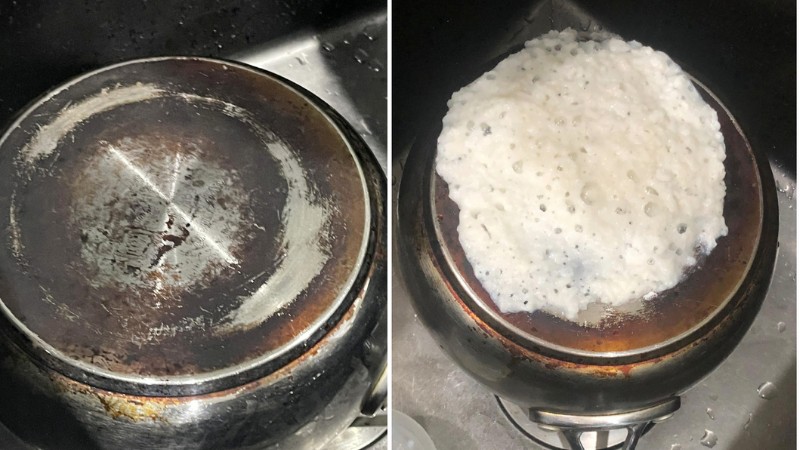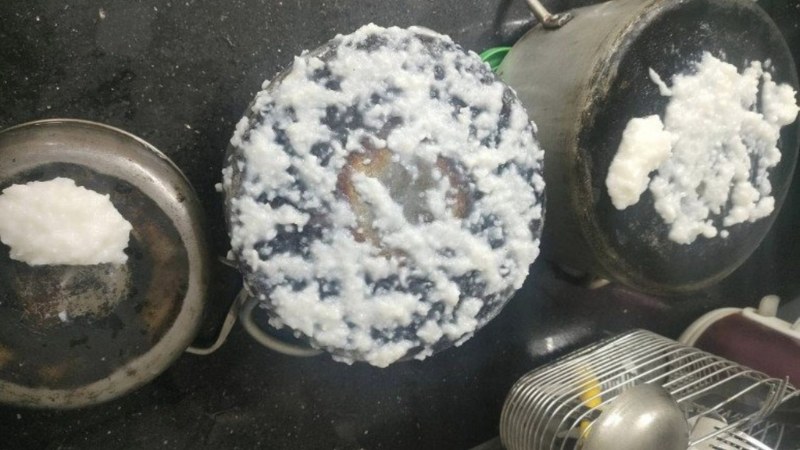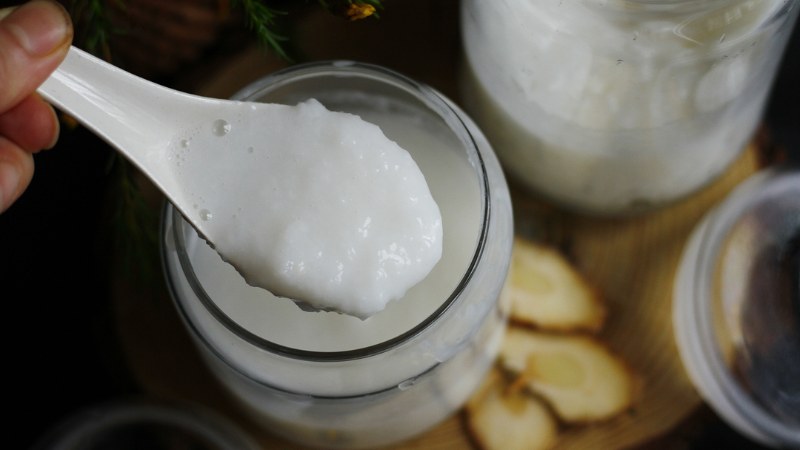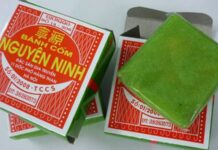As many of us know, me (fermented rice) is a common ingredient in Northern Vietnamese cuisine, adding a tangy twist to hot pots, stews, sour soups, bún riêu, and tofu and snail dishes. The sourness of me stimulates appetite and aids digestion, and it’s also a handy scouring agent for cleaning stubborn pots and pans!
Did you know? You can easily make me at home, and it keeps for a long time without molding.
1 Apply me to the bottom of the pot and let it sit overnight
- Apply me: Spread a thick layer (about 2-3 mm) of me on the entire bottom of the pot.
- Let it sit overnight: Leave the pot with me on it overnight (about 8-12 hours) to let it soak in and adhere firmly.
- Soak in water: Immerse the pot in a basin of water. The me will quickly soften and dissolve, taking the stubborn grease with it.
- Scrub: After it has softened, use a steel ball or a specialized pot scrubber to gently scrub the bottom of the pot. The grime will easily flake off, leaving a shiny surface.
 Apply me to the bottom of the pot and let it sit overnight
Apply me to the bottom of the pot and let it sit overnight
2 Clean a burnt pot bottom with me
Method 1: Direct application of me
- Boil water: Fill a large pot or pan with water and bring it to a boil.
- Add me: Once the water is boiling, add the me.
- Dip the burnt pot: Dip the bottom of the burnt pot into the boiling me solution, ensuring direct contact with the liquid.
- Wait and clean: Leave the pot in the solution for about 3 minutes. Then, remove it and rinse. If the burnt residue persists, gently scrub it with a steel brush, and it will easily come off.
Method 2: Using a diluted me solution
- Prepare the me solution: Mix boiling water with me in a 1:1 ratio.
- Soak a cloth or tissue: Dip a cloth or tissue paper into the hot me solution, wringing out the excess liquid.
- Apply to the burnt area: Place the soaked cloth or tissue on the burnt area.
- Let it sit overnight: Leave it untouched overnight.
- Clean: In the morning, remove the cloth/tissue and rinse the pot with water.
 Clean a burnt pot bottom with me
Clean a burnt pot bottom with me
3 Combine me with baking soda
Ingredients
- 500g of thick me (not the filtered bottled type)
- 100g of baking soda
Instructions
- Mix 500g of thick me with 100g of baking soda.
- Apply the mixture to the bottom of the pot, pan, or wok that needs cleaning.
- Cover with a layer of paper towel to keep it moist and let it sit overnight.
- The next morning, remove the paper towel, scrape off the excess mixture, and use a steel brush to scrub the pot clean.
 Combine me with baking soda
Combine me with baking soda
- Choose me that is fresh, has a brownish-yellow color, and a distinctive aroma.
- You can add a little salt to the me before application to enhance its cleaning power.
- Wear gloves when working with me to avoid skin irritation.
- After cleaning, it is recommended to rinse the pot with hot water and dry it thoroughly.
 Some notes when using me to clean pots and pans
Some notes when using me to clean pots and pans
4 Advantages and disadvantages of using me to clean pots and pans
Advantages
- This method uses natural, safe, and economical ingredients.
- Me is an effective remover of stubborn grease and grime, even from long-term buildup.
- It is a simple and time-saving method.
Disadvantages
- The smell of me can be strong and unpleasant.
- You need to wait overnight for it to work effectively.
- Use it with caution, as me can irritate the skin.
 Advantages and disadvantages of using me to clean pots and pans
Advantages and disadvantages of using me to clean pots and pans
The above are some methods to clean pots and pans with me that we have compiled. Apply these methods to keep your cookware sparkling and in good condition!
Coffee: More Than Just a Drink, It’s a Surprising Source of Benefits for Your Home
Coffee is not only loved for its taste and aroma, but it also comes with a range of health benefits. Studies have shown that coffee can reduce the risk of diseases such as cancer, heart disease, and Alzheimer’s. In addition to promoting overall well-being and mental alertness, coffee has many surprising effects that you may not have expected.
Don’t wipe your dirty screen randomly! Follow this trick for a shiny, dust-free display
Many people have a misconception when it comes to cleaning their TV screens, which can lead to irreparable damage. TVs have a special coating on their surfaces, and if not cleaned properly, this coating can be damaged. As a result, the reflection, static electricity, and color of the image may be diminished.





































